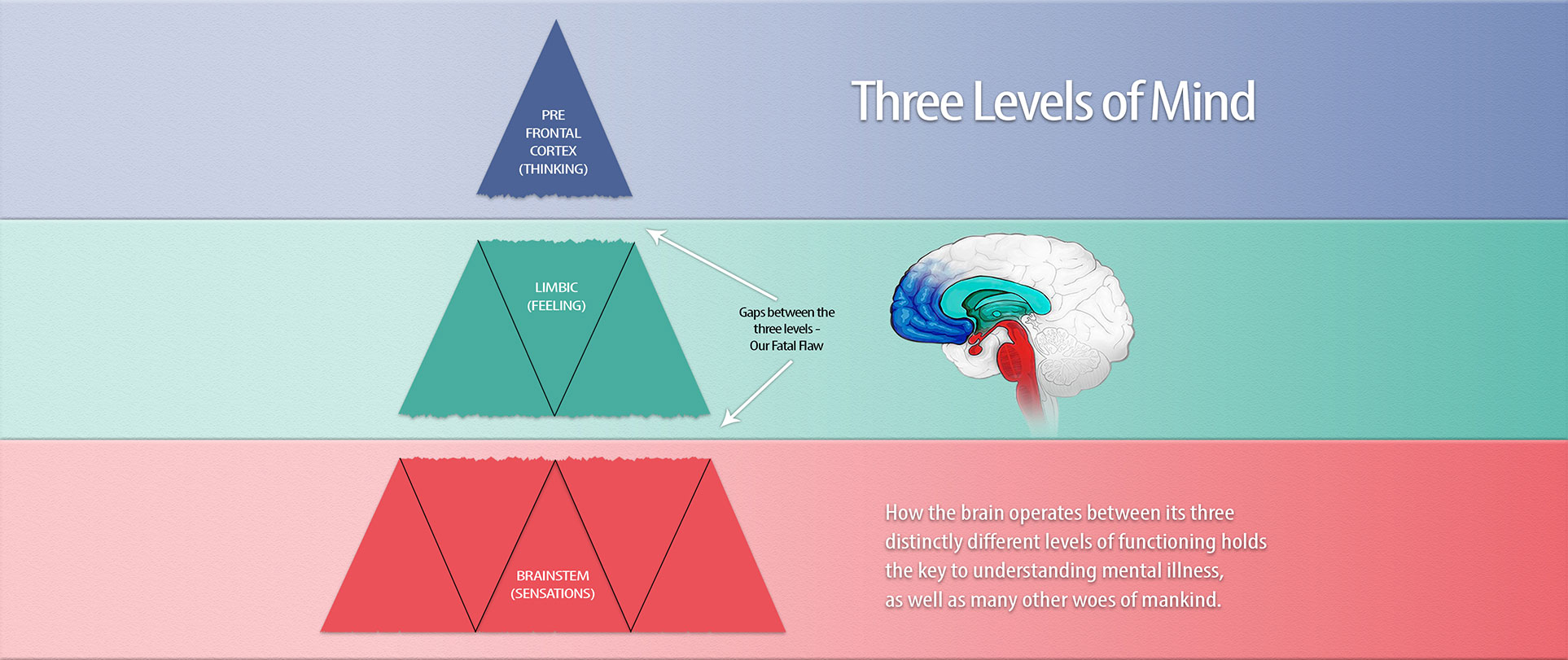The triune brain concept has been around for more than fifty years. Paul McLean (1950’s) proposed that the human brain has three different areas that correspond with the evolution of man.
The brainstem is equivalent to the reptilian brain, the limbic system developed in the mammals, and the cortex developed to make up the three levels of the human brain. This concept has been accepted into the mainstream understanding of the physical make-up of the brain.
What is not understood is that each of these brain areas produce their own states of mind, and each area communicates with the other, mostly in an upward manner, from brainstem to feelings to cognition. The free flow between areas produces a healthily functioning and integrated brain on a psychological level.
The human brain develops in a baby in the same order that it developed during evolution.
For example the baby brain has an almost fully functioning brainstem at birth because the baby needs to be able to breathe, digest its food and have a heartbeat which are physical necessities. What is not fully understood is that the brain is sensing its environment, whether it is safe and joyful, or whether it is unsafe and unloving.
The limbic area develops at around six months and at this stage the baby is mostly a sensing/feeling being. The cortex, or thinking brain does not develop much until eighteen months of age.
The main imprinting that drives the child for the rest of its life occurs during the sensation/feeling part of its development. Obviously this area can be affected throughout a lifetime, but it is generally accepted by neuroscience that the earliest months of life provide for the deepest and most powerful imprinting.
A badly imprinted brainstem from unloving or unaware parents, is the cause of so many mental health problems and dysfunctional emotions later in life.
Much of the present day understanding of mental health disorders is that they can be controlled by using the cognitive mind to treat symptoms. For example Positive Thinking, Mindfulness and Meditation are widely practised within the mental health system to control symptoms.
But this goes against evolution. The brainstem with its imprinting, either good or bad, drives upward into feeling, and then feelings determine the way we react and think about the world.
The brainstem senses, the limbic system feels and the cortex thinks. A fact of brain functioning is that thinking cannot effect what we sense. They are two different languages, so thinking positive and meditation can alter a symptom, but it cannot change the imprinted cause.
I know this because Primal Therapy uses evolution by going back in time. In therapy I started in my cortex where I talked about my problems. Then I felt the underling feelings – gradually at first then in their full force. My dominant underlying feelings were sadness and grief, anger and very extreme loneliness. As the therapy progressed I started to experience sensations and the original imprints.
Experiencing the imprints was an amazing journey for me, because it opened my mind into a space that I never knew existed.
The reason so many people suffer mental health and relationship problems is that their original imprinting is faulty, and this causes dysfunction in the cortex. Things like depression, anxiety, suicide, domestic and international violence and addictions all have their root cause in faulty brainstem imprinting.
Implicit in all this brain functioning is that it is very easy to traumatise a baby’s brain, and our present culture does not support the rearing of healthy children. It is too focused on material wealth and consumerism ( the thinking mind) at the expense of the very powerful social brain (sensations and feelings).
That is why the concept of the triune brain is so important. The sensations and feelings give a human all the real pleasures of life, supplying us with love and meaningful relationships. These areas need careful nurturing, especially in the earliest months of life. The cortex is the thinking part of the brain that can put a man on the moon, but cannot supply a human with love and happiness.
